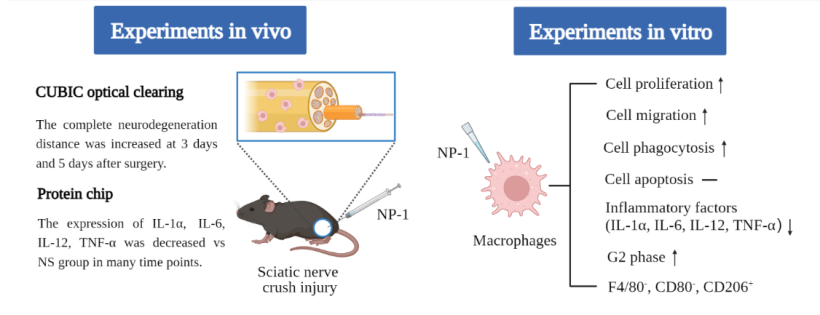中国神经再生研究(英文版) ›› 2024, Vol. 19 ›› Issue (8): 1822-1827.doi: 10.4103/1673-5374.387978
中性粒细胞肽 1激活巨噬细胞:加速瓦勒变性后变性轴突的清除
Neutrophil peptide 1 accelerates the clearance of degenerative axons during Wallerian degeneration by activating macrophages after peripheral nerve crush injury
Yuhui Kou1, 2, 3, #, Yusong Yuan4, #, Qicheng Li1, 3, #, Wenyong Xie1, Hailin Xu1, 2, *, Na Han2, 3, 5, *
- 1Department of Trauma and Orthopedics, Peking University People’s Hospital, Beijing, China; 2National Center for Trauma Medicine, Beijing, China; 3Key Laboratory of Trauma and Neural Regeneration (Peking University), Ministry of Education, Beijing, China; 4Department of Orthopedics, China-Japan Friendship Hospital, Beijing, China; 5Department of Central Laboratory and Institute of Clinical Molecular Biology, Peking University People’s Hospital, Beijing, China
摘要:
在以往研究中,该团队已证实单次肌肉注射中性粒细胞肽 1可以促进坐骨神经挤压损伤后的早期功能恢复。然而,NP-1促进周围神经再生的机制尚不清楚。鉴于中性粒细胞肽 1与巨噬细胞的密切关系,实验假设中性粒细胞肽 1可能通过与巨噬细胞密切相关的机制促进周围神经再生。实验在沃勒氏变性过程中,使用 CUBIC 光学清除技术观察了轴突碎片的吞噬作用。使用蛋白质芯片检测了不同极化状态下巨噬细胞炎症因子的表达。结果显示,中性粒细胞肽 1能促进巨噬细胞的增殖、迁移和吞噬。在中性粒细胞肽 1 的干预下,Wallerian 退化过程中轴突碎片的清除率得到提高。研究还发现,中性粒细胞肽 1 可在体内和体外下调炎症因子白细胞介素1α,-6,-12 和 肿瘤坏死因子α水平。因此,中性粒细胞肽 1可激活巨噬细胞并加速 Wallerian 退化,这可能是中性粒细胞肽 1 加速周围神经再生的机制之一。
https://orcid.org/0000-0003-1829-3852 (Hailin Xu); https://orcid.org/0000-0003-4590-3361 (Na Han)
